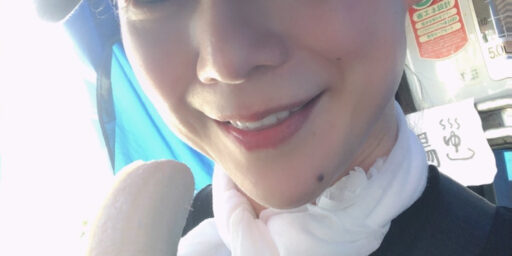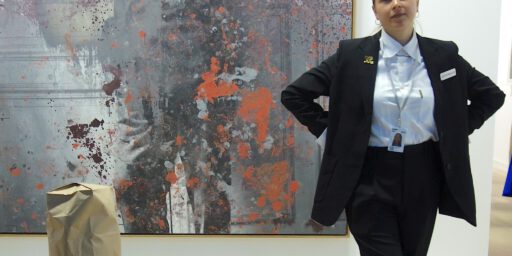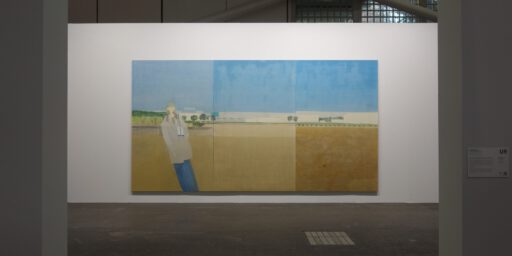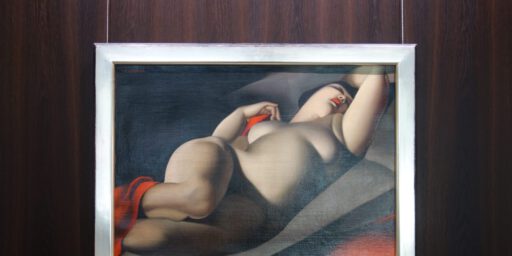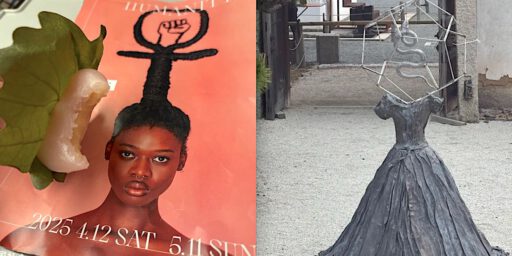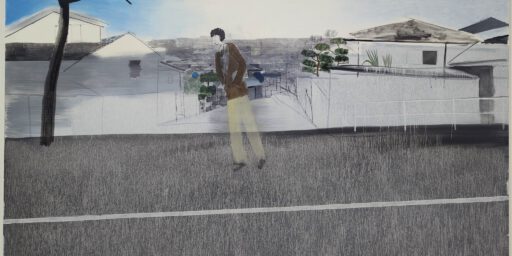ギュスターヴ・クールベ「世界の起源」1866年 Gustave Courbet L'Origine du monde ・The Origin of the World 1866
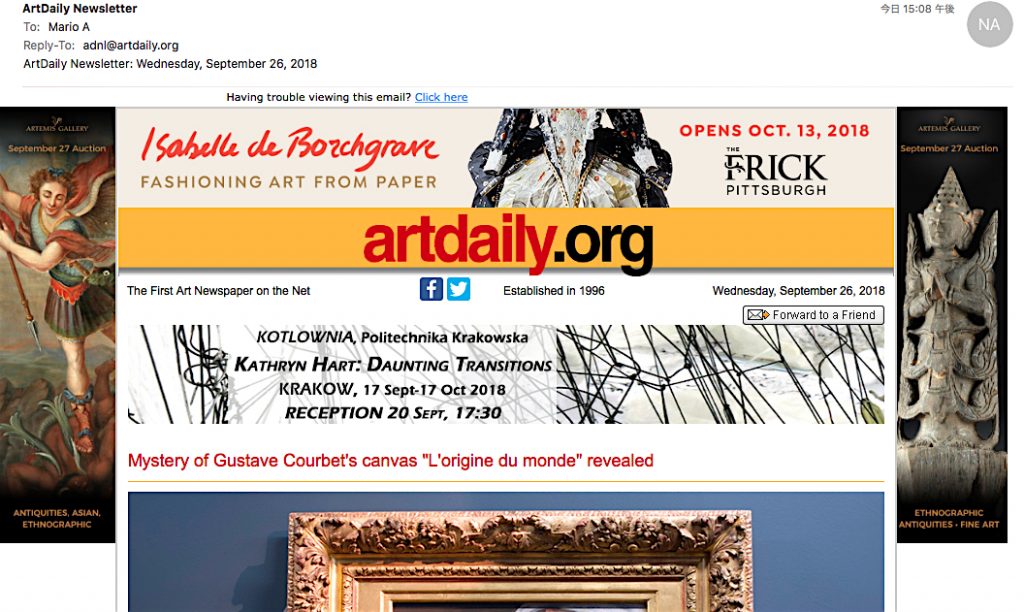
流石、今日のartdailyニュースのトップ記事でございます。何年前、オルセー美術館で鑑賞しましたが、この機会で、一枚目の画像をカムフラージュとして、こちらにアップさせていただきますね。
ヒ・ミ・ツ。
新しい研究により、モデルはJoanna Hiffernan ジョアンナ・ヒファーナン ではなく、Constance Quéniaux コンスタンス・クニョー です。
Léonard Tsuguharu Foujita レオナール・ツグハル・フジタの作品「après Courbet L’origine du monde」も、なかなか良いだと思います。

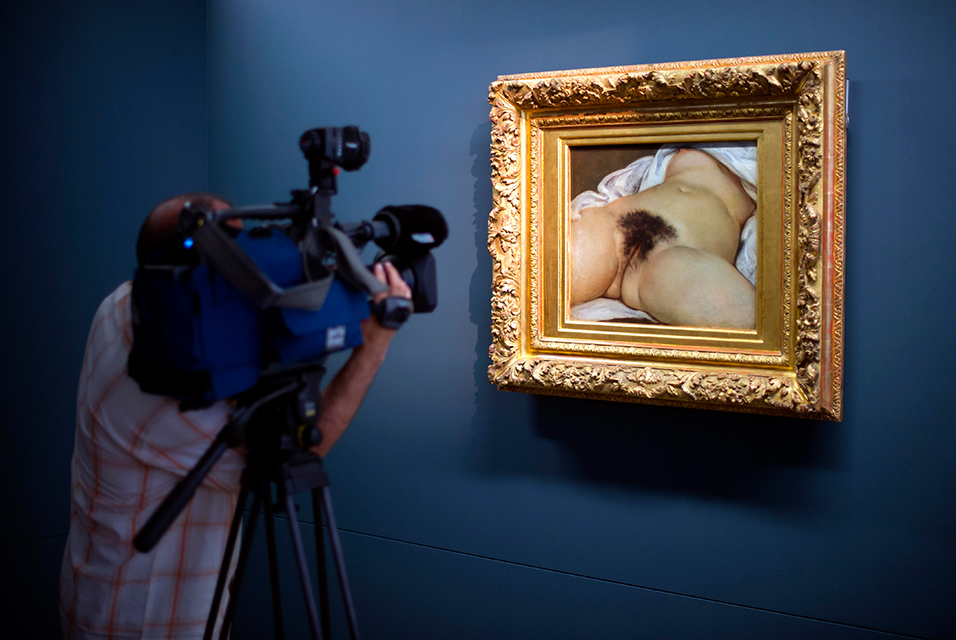
Mystery of Gustave Courbet’s canvas “L’origine du monde” revealed
PARIS (AFP).- One of the greatest mysteries in art history appears to have been solved.
The identity of the model who posed for the most scandalous painting of the 19th century, Gustave Courbet’s “L’Origine du monde” (The Origin of the world), has finally been revealed.
Experts say they are “99 percent sure” the painting’s notoriously naked nether regions belong to the Parisian ballet dancer Constance Queniaux.
The canvas has never lost its power to shock — bringing out the prude in Facebook, which censored profiles using it as late as 2011.
For decades art historians have been convinced that the naked torso and genitalia it depicts belonged to Courbet’s lover, the Irish model Joanna Hiffernan.
In a typically Parisian love triangle, she was also romantically linked with his friend, the American artist James Whistler.

But doubts persisted — mainly because the dark pubic hair in the painting did not correspond with Hiffernan’s mane of flaming red curls.
Now documentary evidence found in the correspondence between the French writers Alexandre Dumas fils — the son of “The Three Musketeers” author — and George Sand points directly to a former dancer at the Paris Opera.
Queniaux was a mistress of the Ottoman diplomat Halil Sherif Pasha — aka Khalil Bey — when the picture was painted in the summer of 1866.
And it was he who commissioned the painting from Courbet for his personal collection of erotica.
Competing courtesans
French historian Claude Schopp discovered the Queniaux connection when he was going through copies of Dumas’ letters for a book.
One particular passage perplexed him: “One does not paint the most delicate and the most sonorous interview of Miss Queniault (sic) of the Opera.”
It was only when he consulted the handwritten original that he realised there had been a mistake in its transcription. “Interview” was in fact “interior”.
“Usually I make discoveries after working away for ages,” said the writer, whose new book on the find will be published this week.
“Here I made it straight away. It almost feels unjust,” Schopp joked.
Schopp shared his discovery with the head of the French National Library’s prints department, Sylvie Aubenas, who is also convinced that Queniaux was the model.
“This testimony from the time leads me to believe with 99 percent certainty that Courbet’s model was Constance Queniaux,” she confirmed to AFP.
Queniaux was 34 at the time, and having retired from the Opera, was competing with the famed courtesan Marie-Anne Detourbay for Halil Sherif Pasha’s affections.
Detourbay, sometimes known as Jeanne de Tourbey, held a famous salon and would later become the comtesse de Loynes. She was also thought by some to be the model for “L’Origine du monde”.

Constance Quéniaux, ici photographiée par Disdéri, serait le modèle de Gustave Courbet pour « L’Origine du monde ». BnF/Département des estampes et de la photographie
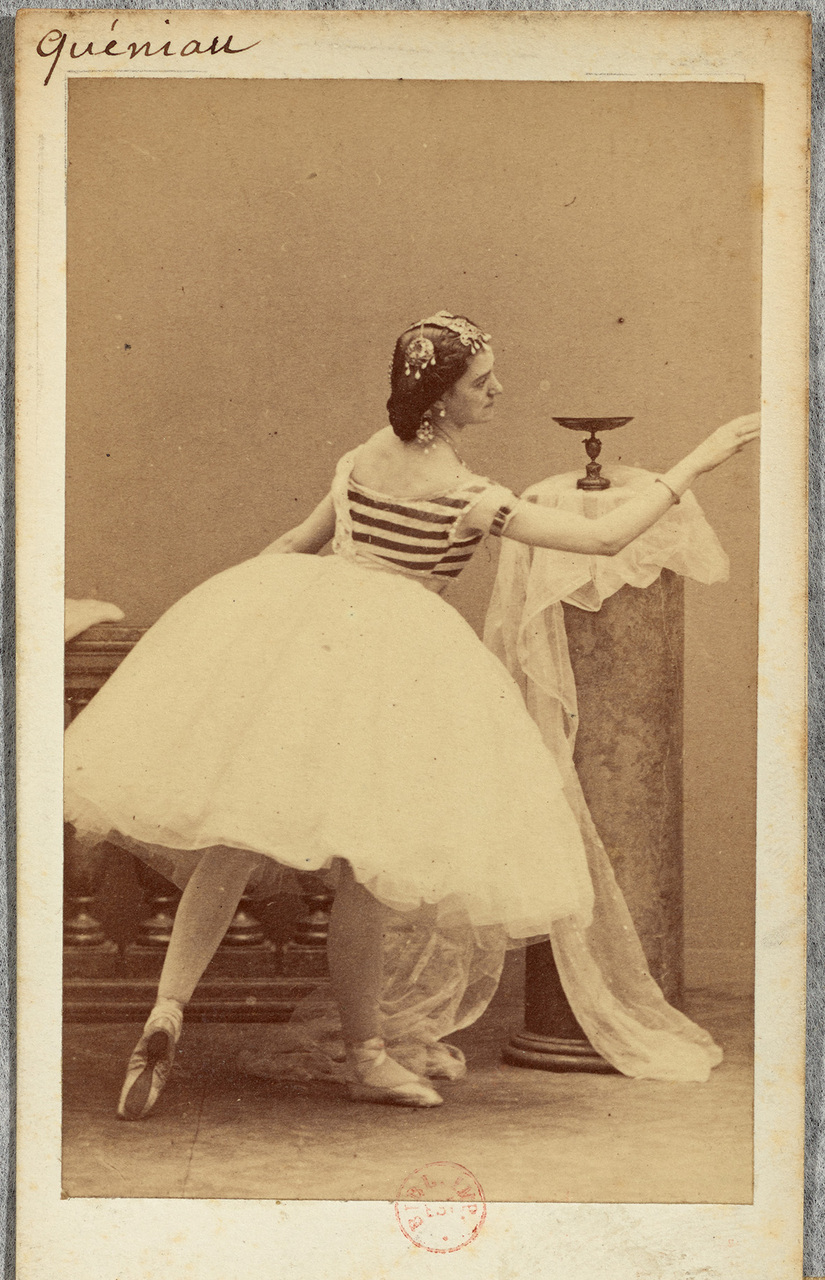
Constance Quéniaux, photographiée par Disdéri./BnF/Département des estampes et de la photographie
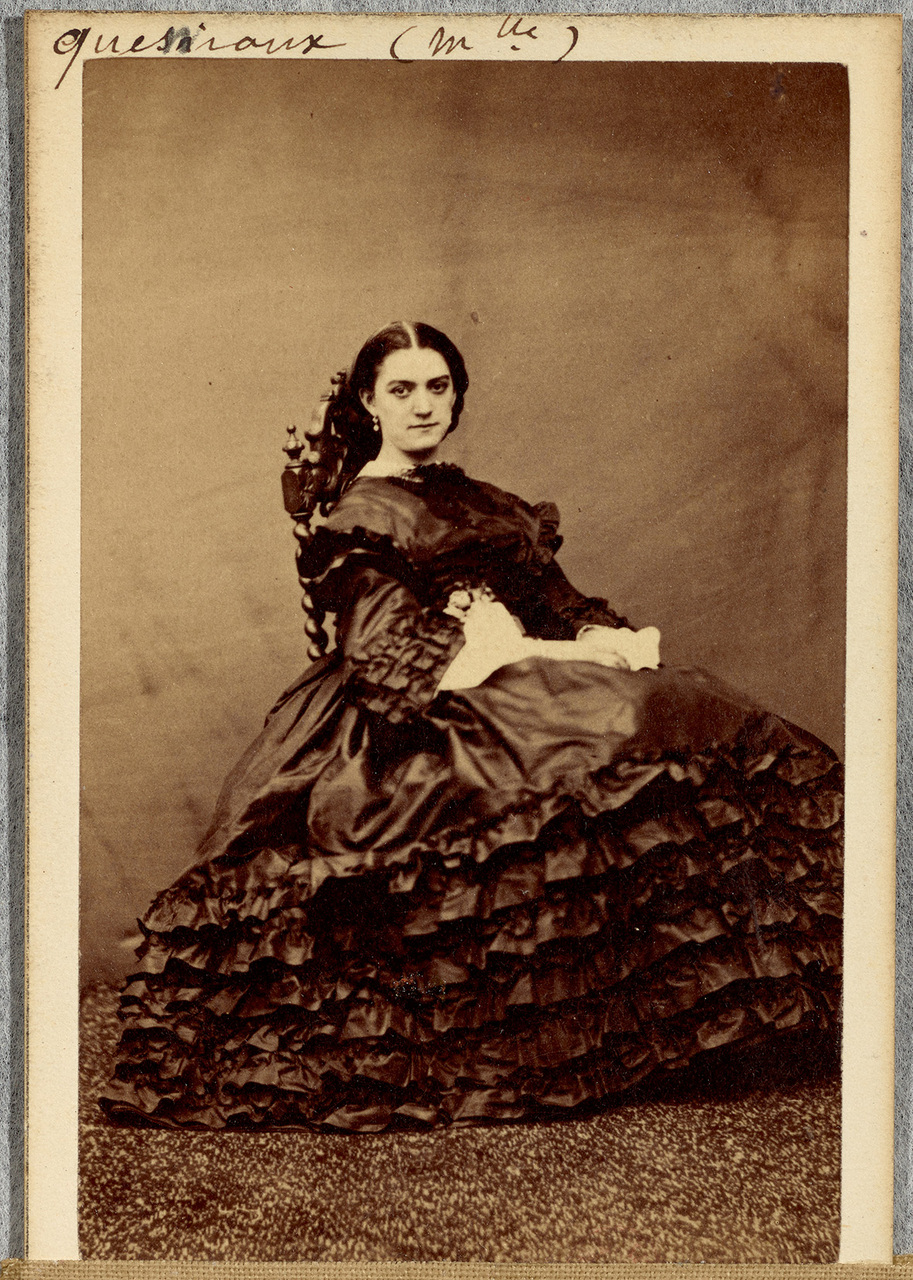
Constance Quéniaux, photographiée par Pesme en 1861./BnF/Département des estampes et de la photographie
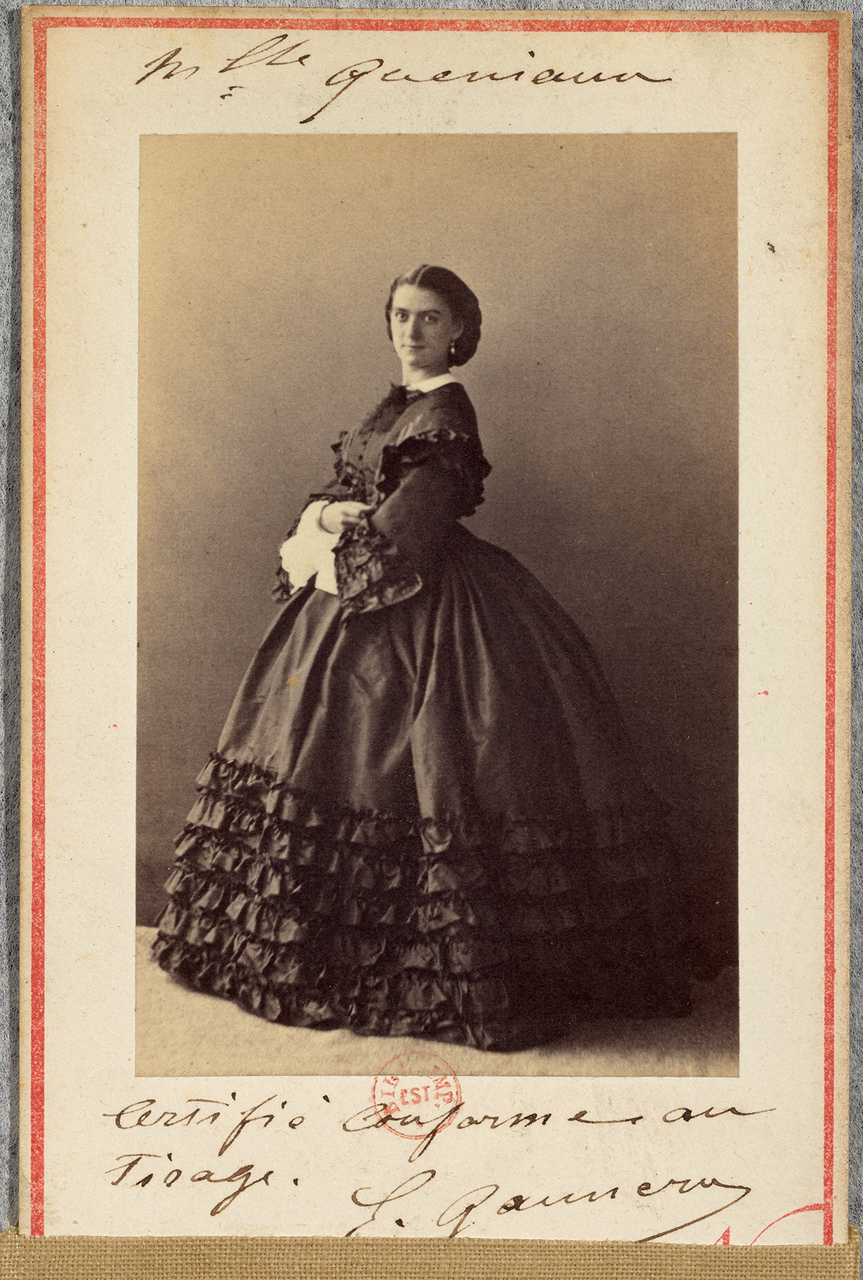
Constance Quéniaux photographiée par Nadar en 1861./BnF/Département des estampes et de la photographie
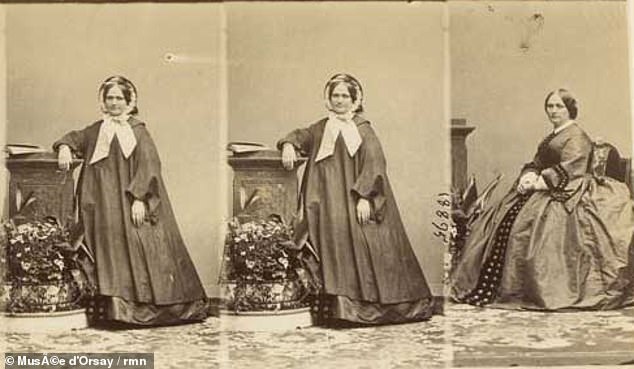
‘La Traviata’ link
But Aubenas said contemporary descriptions of Queniaux’s “beautiful black eyebrows” corresponded better with the model’s luxuriantly bushy maidenhair.
The library has several photographs of her including one by the famed photographic pioneer, Nadar.
Aubenas believes the secret of the model’s identity was known by the cognoscenti but was lost over time as Queniaux became a highly respectable lady of leisure known for her philanthropy.
Another discovery by Schopp helped to clinch the argument, she said.
When she died in 1908, Queniaux left a Courbet painting of camellias in her will at whose centre is a lusciously open red blossom.
Camellias were strongly associated with courtesans at the time thanks to Dumas’ novel “The Lady of the Camellias”, which was adapted into Verdi’s opera “La Traviata”.
“What better tribute from the artist and his patron to Constance?” Aubenas said, who believes it may have been a gift from Halil Sherif Pasha.
Born in Cairo, the pasha was a renowned art collector and gambler who came from a Turkish-Albanian family from what is now northern Greece.
He commissioned a series of major works from Delacroix including “The Women of Algiers” and Ingres’ equally iconic and extravagantly fleshly depiction of a harem, “The Turkish Bath”.
https://www.afp.com/en/news/206/mystery-arts-most-scandalous-picture-revealed-doc-19d7it3
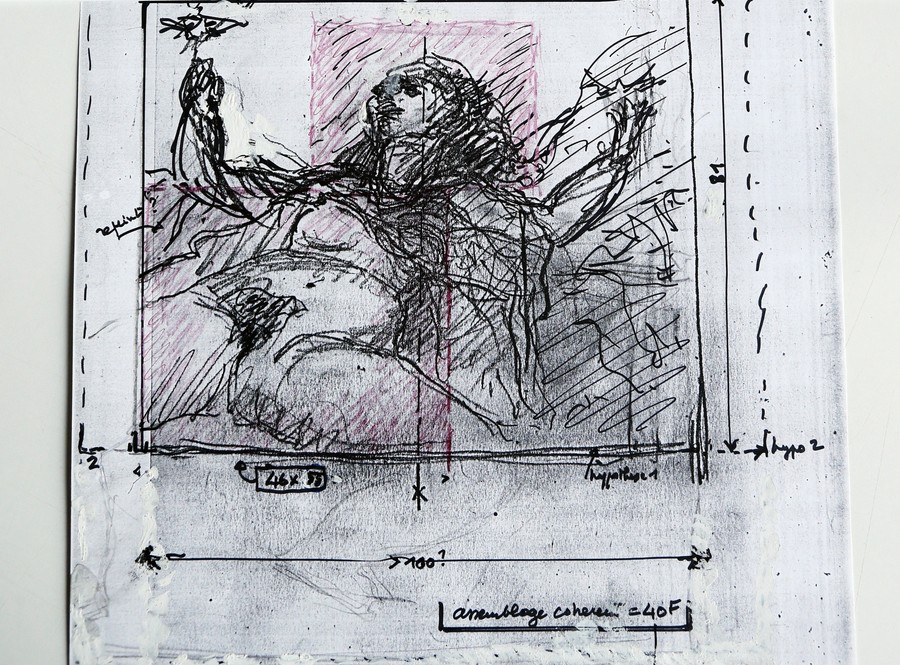
https://ja.wikipedia.org/wiki/世界の起源

.jpg)
Huile sur carton entoilé
Annoté “après Courbet, L’origine du monde” en bas à droite
33 x 41 cm, Succession Kimiyo Foujita, no date
参考, compare with:
藤田嗣治・Léonard Foujitaの作品との出会い
Encountering the works by Léonard Tsuguharu Foujita
https://art-culture.world/articles/foujita-tsuguharu-leonard-tsuguharu-foujita-kimiyo/
up-date 2024/5/7:

“L’Origine du monde” de Gustave Courbet tagué par une artiste luxembourgeoise
par Jolan Maffi
Publié le 7 mai 2024 à 17h43
Mis à jour le 7 mai 2024 à 17h43
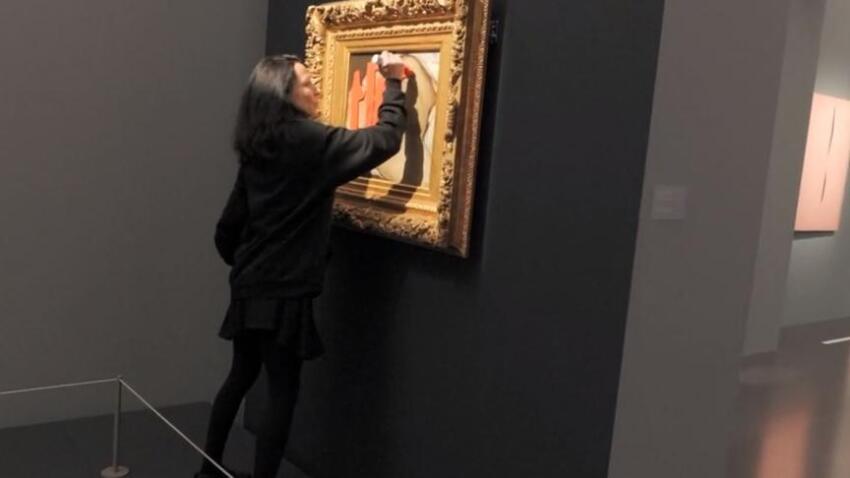
Une militante inscrit à l’encre rouge le mot ”MeToo” sur la vitre protégeant “L’Origine du monde” – Capture Vimeo
L’œuvre de Gustave Courbet, “L’Origine du monde”, ainsi que cinq autres, ont été prises pour cible par des militantes et artistes féministes.
Après La Joconde aspergée de soupe en janvier dernier par des militantes écologistes, c’est au tour du plus célèbre entrejambe de l’histoire de l’art d’être vandalisé : L’Origine du monde, illustre tableau de Gustave Courbet, a été pris pour cible ce lundi 6 mai. Exposée au Centre Pompidou de Metz, cette représentation d’un nu féminin en gros plan a été recouverte du mot “MeToo” écrit à l’encre rouge.
Cinq autres œuvres ont été visées, tandis que deux femmes de 31 et 37 ans ont été arrêtées et placées en garde à vue dans le cadre d’une enquête pour dégradation de biens culturels en réunion. Une troisième aurait pris la fuite et serait toujours recherchée. Dans tout ce bazar, une œuvre est portée disparue : une broderie d’Annette Messager semble en effet avoir été volée lors de la prestation.
Un geste artistique ?
À l’origine de cette action, l’artiste franco-luxembourgeoise Deborah de Robertis. Cette dernière l’a effet revendiquée sur ses réseaux sociaux, tout en affirmant être la détentrice de l’œuvre disparue : “Je suis l’organisatrice exclusive de cette performance et attends d’être convoquée par les services de police qui savent qui est mon avocate. Je suis en possession de l’œuvre d’Annette Messager que je me suis réappropriée et qui est mienne désormais.”
Dans un communiqué, le centre Pompidou-Metz a déclaré que des individus “ont fait diversion auprès du personnel de médiation et de sécurité, permettant aux autres membres du groupe de taguer les œuvres.”
“Avec tout le respect que nous portons aux mouvements féministes, nous sommes choqués de voir vandaliser des œuvres d’artistes, notamment d’artistes féministes, au cœur des combats de l’histoire de l’art”, a ajouté la directrice du musée Chiara Parisi.
Côté politiques, la pilule a du mal à passer. Si François Grosdidier, le maire de la ville, qualifie les militant·es de “fanatiques féministes” dans un communiqué, la ministre de la Culture, Rachida Dati, s’est elle aussi permise une déclaration : “Aux ‘activistes’ qui pensent que l’art ne serait pas assez puissant pour porter un message par lui-même, il faut le redire : une œuvre n’est pas une pancarte qu’on pourrait colorier avec le message du jour”, écrit-elle sur X.
Un amour du choc
Deborah de Robertis n’en est pas à son coup d’essai. En 2014, déjà, elle créait le scandale en reproduisant en direct le tableau, les jambes écartées et sans culotte, au musée d’Orsay. En 2018, pendant les manifestations, elle s’était illustrée seins nus en Marianne, accompagnée de quatre autres femmes, pour défier pacifiquement les policiers. Nouveau scandale deux ans plus tard, en 2020, lorsqu’elle pose complètement nue devant la grotte du sanctuaire de Lourdes. Pour cette action, elle a été condamnée à 2000 euros d’amende.
Sa récente intervention semble donc s’inscrire dans un geste artistique plus vaste, où le sexe et les femmes occupent une place centrale. Son travail était lui-même exposé au Centre Pompidou de Metz au moment de l’intervention.
2024/5/8 up-date:
Artist and Protestors Tag Gustave Courbet’s ‘Origin of the World’ with the Words ‘Me Too’
BY TESSA SOLOMON
May 7, 2024 4:54pm
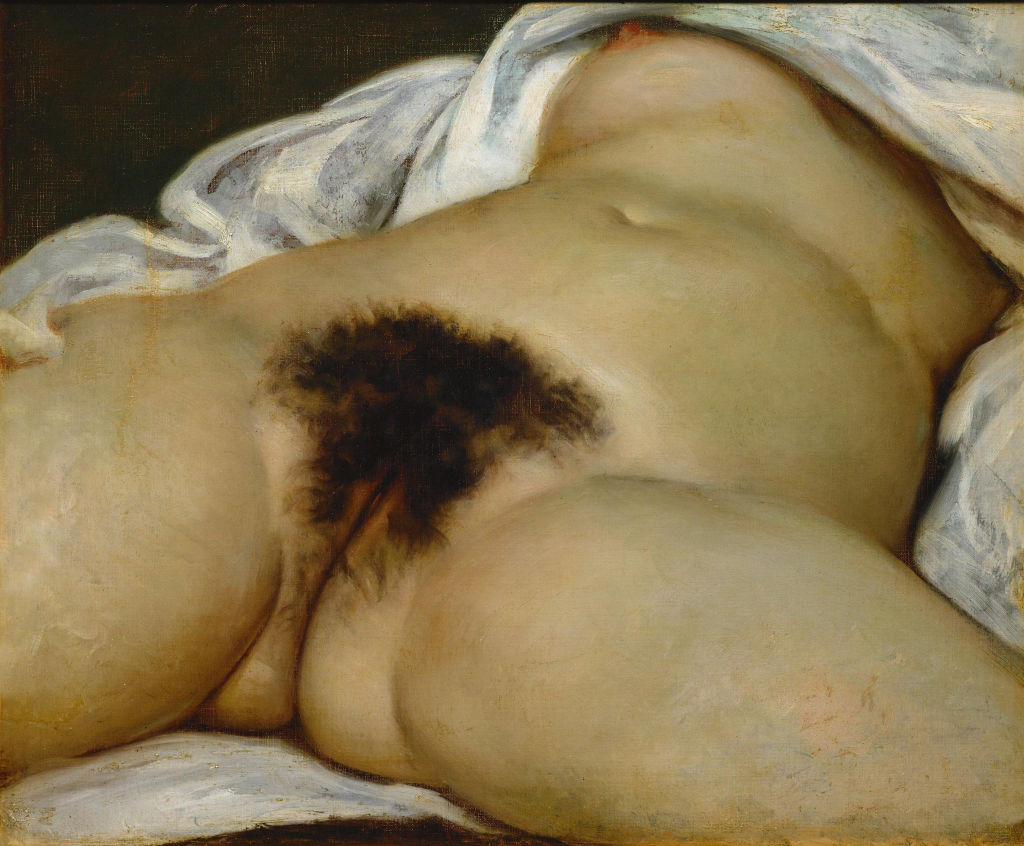
The Origin of the World (L’Origine du monde). Found in the Collection of Musée d’Orsay, Paris. (Photo by Fine Art Images/Heritage Images/Getty Images) Getty Images
Gustave Courbet’s infamous nude painting L’Origine du monde (The Origin of the World) was targeted over the weekend by protesters who tagged it with the words “Me Too.”
The 1886 painting is on display at the Centre Pompidou-Metz in northern France in the show “Lacan, The Exhibition: When Art Meets Pscyhoanalysis” (through May 27), which examines theories of the unconscious proposed by the French psychoanalyst Jacques Lacan, who once owned L’Origine du monde. The work is on loan from the Musée d’Orsay in Paris. A spokesperson for the Centre Pompidou-Metz confirmed that, including the Courbet, five works in total in the show were defaced with the slogan “Me Too”. An embroidered piece by the French artist Annette Messager, titled I Think Therefore I Suck (1991), was also taken from the museum.
The Luxembourg-born artist Deborah De Robertis claimed responsibility for the vandalism and theft in a video posted to Vimeo, titled On ne sépare pas la femme de l’artiste (“the woman cannot be separated from the artist”). In a statement, the artist said the protest intended to expose “misogynistic divide” in the art world. The video shows two women writing on the paintings the slogan “Me Too” popularized by the eponymous social movement that emerged in 2017 in response to a slew of high-profile cases of sexual assault and harassment. Among the works tagged in the museum is De Robertis’s own photograph Mirror of Origin.
In the video, protesters chant “Me Too” before they are removed from the premises by security staff. According to the Art Newspaper, the mayor of Metz, Francois Grosdidier, called the protest “a new attack on culture, this time by fanatic feminists”. Metz police have not said if the protesters have been charged.
This is not the first feminist protest staged by De Robertis at a museum, or even the first targeting of Courbet. In 2014, she exposed her vulva in front of Origin of the World at the Musee d’Orsay, and two years later, she returned to the museum to strip off her clothes—save for a portable video camera tied around her neck—and lay on the floor in front of Edouard Manet’s nude painting Olympia (1863). The latter protest led to a charge of public indecency and nearly two days detained in a jail cell.
She said in her statement: “I call on all women, with or without vulvas, all intersex, trans and non-binary people, and all underrepresented people—whether artists, assistants or interns in the art world—to dare to express yourself.”
Courbet’s Famous Painting of a Vulva Tagged With “MeToo”
“The Origin of the World” was one of several artworks targeted in a performance by artist Deborah De Robertis at the Centre Pompidou-Metz.
Maya Pontone 9 hours ago
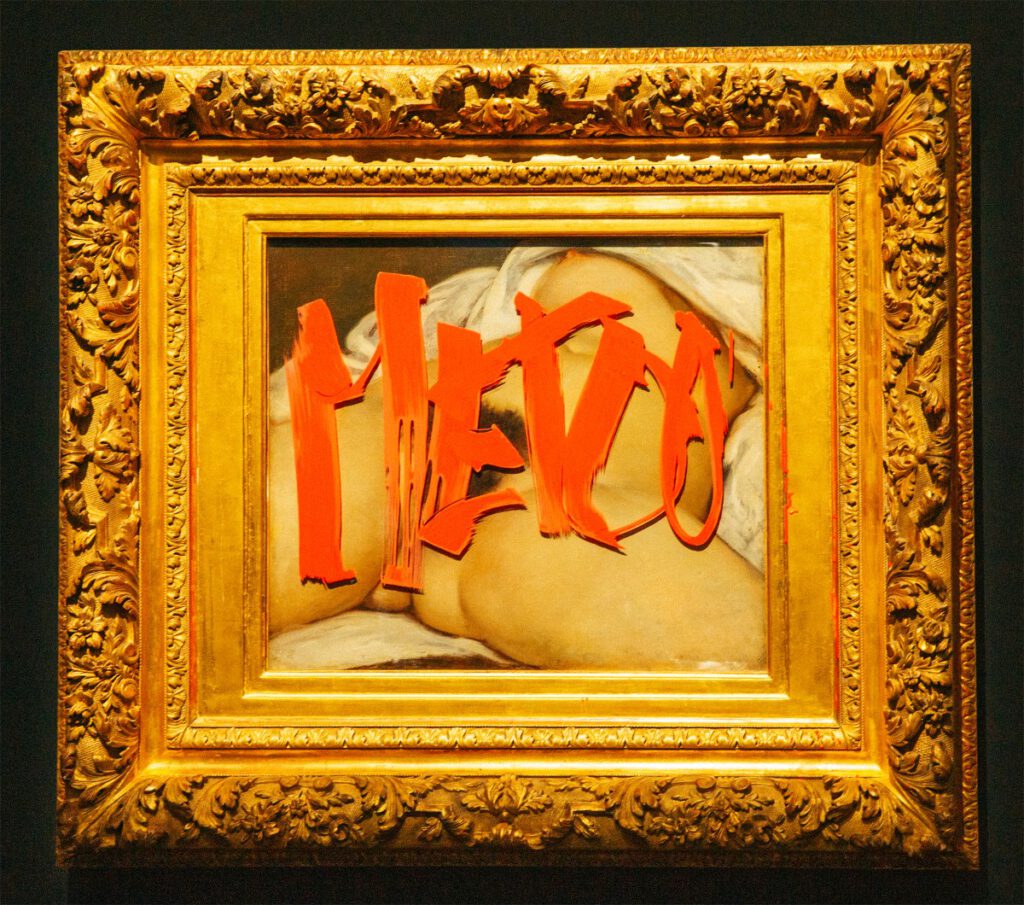
Two women tagged the phrase “MeToo” on the protective glass covering Gustave Courbet’s painting “The Origin of the World” (1866), which features a close-up view of a vulva, in a stunt performance at the Centre Pompidou-Metz in France yesterday, May 6. The work was one of five pieces targeted at the museum, where the historically scandalous nude is on loan from the Musée d’Orsay in Paris for an exhibition centered on French psychoanalyst Jacques Lacan, who bought the painting in 1954.
The action was conceptualized by French-Luxembourger artist Deborah De Robertis, who previously exposed her genitals in front of Courtbet’s painting in a 2014 conceptual performance at the Musée d’Orsay that resulted in her arrest. A photograph of that intervention, titled “Mirror of Origin” and currently on display as part of the Centre Pompidou-Metz exhibition, was among the works spray painted by the performers, alongside a photographic print by Valie Export.
“I violated museums, from the Orsay Museum to the Louvre Museum to the Pompidou Center. I entered them by force, without consent or permission, to claim my place in history,” De Robertis wrote in a statement yesterday, May 6.
A video documenting the intervention showed two women scrawling the words “Me Too” on the protective glass of various artworks while shouting, “Me Too!”
Metz prosecutor Yves Badorc told AFP that the two women who defaced the artworks were arrested. While Courbet’s painting was protected by glass, police are still assessing the damage to the other works. While it is unclear whether the two women currently face charges, De Robertis told Hyperallergic that they have been released. The artist also claimed that the paint can be removed with water.
During the performance, De Robertis also stole an embroidery work by French visual artist Annette Messager, “I Think Therefore I Suck” (1991), according to performance documentation. In another video published to Vimeo, De Robertis appears to remove the work from its frame before stuffing it into a dark tote bag.
Hyperallergic has reached out to Messager and the Centre Pompidou-Metz for comment.
The provocative performance is just the latest museum disruption staged by De Robertis. In 2017, she was charged with sexual exhibitionism for a performance at the Louvre that involved exposing her vagina in front of the “Mona Lisa” while shouting, “Mona Lisa, my pussy, my copyright” through a megaphone. While she was acquitted on the sexual exhibitionism charge, she ultimately received a 35-hour public service work sentence for biting a security guard’s jacket when her performance was forcibly stopped.
She has also been arrested for nude performances at the Maison Européenne de la Photographie and the Musée des Arts Décoratifs in Paris, and at The Sanctuary of Our Lady of Lourdes, one of France’s holiest sites in Christian faith.

Artist Deborah de Robertis posing in the exhibition Lacan, l’exposition: Quand l’art rencontre la psychanalyse at the Centre Pompidou-Metz. The photo blurring was done by the artist. (© Deborah de Robertis)
A separate video released in conjunction with De Robertis’s most recent performance appears to show Messager’s artwork hanging in a bedroom where Bernard Marcadé, one of the curators of the Lacan exhibition, is shown lying on a bed while talking to the artist. In the open letter published alongside the performance, De Robertis accuses Marcadé of sexually abusing her when she was 26 years old.
Hyperallergic could not independently verify the allegations and has contacted Marcadé for comment.
The missive also names several other curators, collectors, artists, and historians, accusing them of various abuses including assault, harassment, manipulation, and intimidation.
The museum intervention prompted a critical response from French Minister of Culture Rachida Dati, who wrote on X, “To the ‘activists’ who think that art would not be powerful enough to carry a message on its own, it must be said again: A work is not a placard that can be written on with the message of the day.”

Other artworks were also painted with the words “MeToo,” including Deborah De Robertis’s own “Miroir de l’origine” (2014).
Decrying widespread “patriarchal violence” and a “misogynistic divide” in the art world, De Robertis called on “all women, with or without vulvas, all intersex, trans and non-binary people, and all underrepresented people” to dare to express themselves, citing artists including Ana Mendieta, Orlan, Valie Export, and Louise Bourgeois whose own work has been shown at the museum.
“I really want to point out the fact that people are shocked by a symbolic feminist gesture that actually inverses a power relation,” De Robertis told Hyperallergic.
“Why are we shocked when an artist does a symbolic gesture to denounce systemic violence and abuse?”
https://hyperallergic.com/912144/courbets-famous-painting-of-a-vulva-tagged-with-metoo/
ここに載せた写真やスクリーンショットは、すべて「好意によりクリエーティブ・コモン・センス」の文脈で、日本美術史の記録の為に発表致します。
photos: cccs courtesy creative common sense
